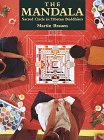
 Das
Mandala; Dumont, ISBN 3770125096 from Amazon.com
Das
Mandala; Dumont, ISBN 3770125096 from Amazon.com
 Mandala,
Il cerchio Sacro del Buddhismo Tibetano, Sovera Editore
Mandala,
Il cerchio Sacro del Buddhismo Tibetano, Sovera Editore
 De
Mandala, Asoka
De
Mandala, Asoka
 Boston:
Shambhala, 1997. Pp. 151. ISBN 1-57062-296-5.Available in English at Amazon
Boston:
Shambhala, 1997. Pp. 151. ISBN 1-57062-296-5.Available in English at Amazon
and several other languages.
Amazon.com: After introducing
the basic theory and practice of mandalas, Martin Brauen describes the main Tantric
Buddhist worldview with the aid of computer-generated models. To provide a deeper
understanding of the mandala's function, the rich and sacred symbolism of the
famous Kalachakra mandala, in its various stages, is then explained in great detail.
Western interest in the philosophic, religious, and psychological aspects of the
mandala is discussed in the final chapter. Several different approaches to the
mystery of mandalas are presented, not with the intention of transmitting incontrovertible
truths, but as a means for readers to develop their own understanding of the Tantric
worldview.
Please share your
opinion of this book with us.
Review by Andy Wistreich:
Overall
Rating: 
I found
this book very helpful. In particular I liked the way that it illustrates and
describes the correlations and parallels between the dimensions and nature of
the universe, the practioners' body and the mandala.
Review by Rudy
Harderwijk:
Overall Rating: 
As
a general book on mandalas in the Tibetan tradition, this is an exciting exploration
with great illustrations, based on thorough knowledge of the tantric system.
However, for a practitioner of Kalachakra, who intends to practice meditation
and visualisations, this book is a 'one-of-a-kind' in the best sense of the words.
The book initially struck me as a 'picture book', laden with high quality images
and graphics, and thus a welcome change to the scholarly and usually non-illustrated
commentaries.
However, when I picked it up later, I realised not only that
a (good) picture can say more than a thousand words, but the text contains a wealth
of detailed information on many aspects of the Kalachakra mandala and its symbolism
in the widest sense of the word. I found this book to be considerably 'larger'
than its already large size suggests. Especially, when combined with a very precious
scholarly work like Vesna Wallace's 'Inner Kalacakratantra', it leaves very little
to wish for, and leaves one with hardly any excuse to start some serious practice...
Unless you are not interested in practice and visualizing the mandala, this
book is a 'must-have'.
Please share your opinion
of this book with us.
Click for an extensive review
by Frank J. Koron (Curator of Asian and Middle Eastern Collections Museum
of International Folk Art Santa Fe, New Mexico fjkorom@nm-us.campus.mci.net)
An extract:
This lavishly illustrated book .... provides us with the
most detailed study of the mandala form's conceptual basis, its visual representations
in a number of media, and its ritual usages. There is also a useful conclusion
drawing on universal notions of the mandala developed by such noted Europeans
as Carl Gustav Jung. ... Brauen's book is one of the clearest and most lucid expositions
of mandala theory and practice to appear in recent years. His use of computer-generated
images as an aid to understanding mandala form will assist Western students in
grasping the subtleties of Tibetan philosophy and spirituality. As such, it is
destined to become a classic both in the classroom and in the public reader's
library.
From the Amazon
website: 'A mandala is not a psychic diagram!', June 30, 1999
Reviewer:
khandro@videotron.ca
Overall Rating: 
There have been 3 or 4 other books on the subject to my knowledge, but this is
by far the most extensive. Prefaced by remarks from H.H. Dalai Lama and focussing
mainly on the Kalachakra tradition, it gives examples from other teachings, too.
It provides a complete explanation of the mandala in tangka form, in architectural
structures such as various stupas and monasteries, as well as the mandala offered
in preliminary tantric practice. Besides scroll paintings and the familiar sand-painting
forms, we see a delightful 3-dimensional zhi kro carved model among the many beautiful
photographs and illustrations. Brauen reveals in detail the Buddhist cosmogony
and Hindu mythology that is the foundation for mandalas and the deities that dwell
in them. An extensive researcher with profound understanding, the jacket reveals
that Professor Brauen, who is chairman of the Department of Tibet, Himalayas and
Far East at the Ethnographic Museum of the University of Zurich, Switzerland is
currently working on a computer animation of the Kalachakra cosmos.
Please
note that we added links to Snow
Lion and Amazon
and for many of the books;
if you intend to order these (or other) books
online with them,
then clicking on our links will generate some money for
us to keep the Network going.